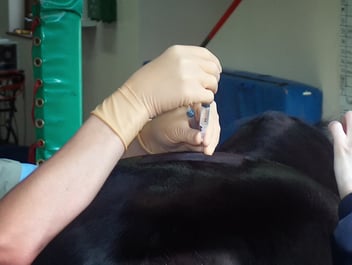Technique Tuesday - Arterial blood samples in Foals
For this Today's Technique, our co-founder and equine veterinary surgeon, Jennifer Corley, is sharing her expertise on arterial blood samples in foals. Have questions or comments? Drop them in the comment form below, and Jennifer will be more than happy to help! Stay tuned for more exciting insights and techniques.


Indications
Various severe conditions, including pneumonia (as a standalone infection or secondary to sepsis), perinatal asphyxia syndrome, fractured ribs, and avermectin overdoses (especially moxidectin), can affect foals' respiratory systems. These conditions often lead to decreased oxygen and increased carbon dioxide in the blood, which, if left untreated, can result in organ damage or mortality. Early recognition and intervention are critical. Treatments may involve intra-nasal oxygen, medications like caffeine to increase respiratory rate, or mechanical ventilation. Determining appropriate treatment and oxygen levels necessitates measuring arterial blood oxygen and carbon dioxide lev
Equipment
· Clippers with a fine (no. 40) blade
· Gauze swabs soaked in 4% chlorhexidine scrub solution
· Gauze swabs soaked in surgical spirit
For arterial blood gas collection:
· 2-3ml syringe flushed with sodium heparin solution
· 25-Gauge 1.6cm needle (for dorsal metatarsal artery)
· 23-Gauge 1.6cm needle (for collection from the median artery)
For arterial catheterisation:
· 20-gauge 4.5cm (1.75 inch) polyurethane Seldinger-technique arterial catheter
· Short narrow extension set
· 2% mepivacaine (1ml drawn up in a 2-3ml syringe with a 23-25 gauge needle)
· Surgical gloves
· Super-glue (cyanoacrylate adhesive)
· Injection cap or three-way tap
· Clean gauze swabs
· Zinc oxide tape
· Vetwrap
· 5ml syringe filled with 0.9% sterile saline with 5 units/ml heparin
Technique for Dorsal Metatarsal Artery Blood Collection
Locate the dorsal metatarsal artery below the hock on the lateral hind leg. Prepare a 4 by 8cm clipped area, ensuring the foal's comfort in lateral recumbency. Clean the skin and consider local anaesthetic only if the foal is highly reactive. Insert the needle at a flat angle (10-20 degrees), observing for freely flowing bright red arterial blood. In unwell foals, it might be necessary to compare arterial and venous blood gas results to confirm accurate arterial sampling.
Catheterisation
When placing a catheter, select a distal site in the straight part of the dorsal metatarsal artery just below the hock. Follow a complete surgical scrub and use surgical gloves. Insert the catheter flatly at a 10-20 degree angle, ensuring a blood flash in the hub before advancing. Secure the catheter immediately, support it with gauze, and wrap it securely. Inject 0.3ml of undiluted (25,000 units/ml) heparin into the catheter for anticoagulation.
Median Artery Blood Collection
Palpate the median artery on the caudomedial side of the radius. With the foal in lateral recumbency and the area prepared, collect blood by directing the needle at a 90-degree angle to the artery. Specially designed blood gas syringes can be extremely useful for this technique as the blood will ‘flash’ into the syringe when the needle enters the artery.




